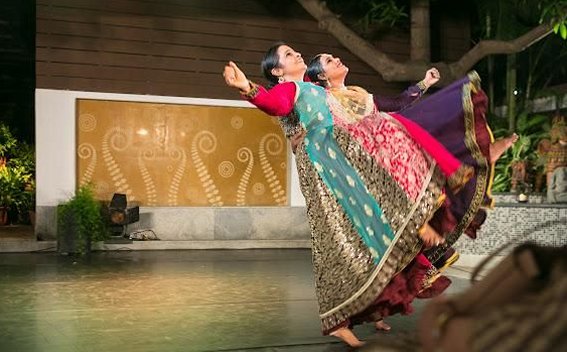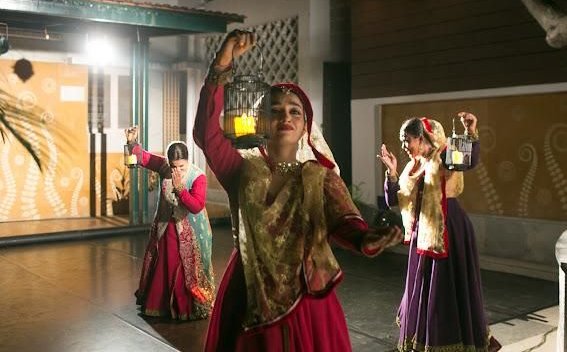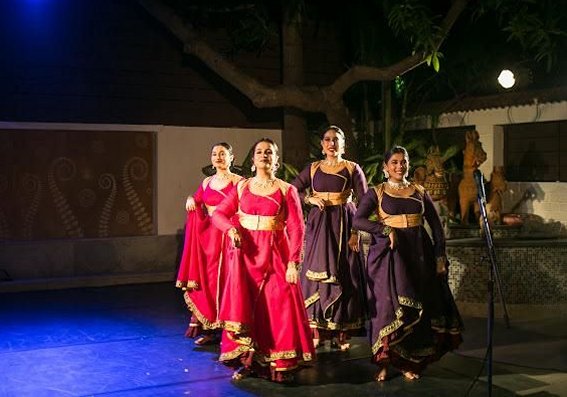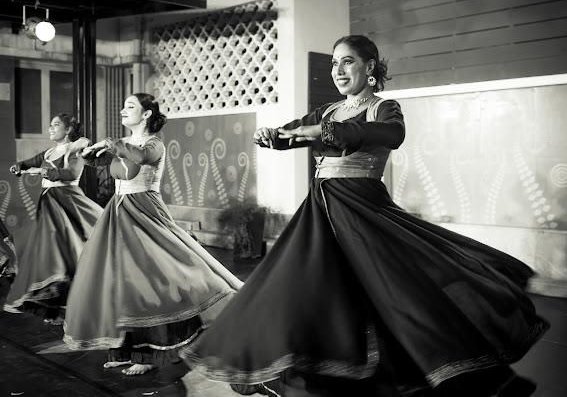
|   |

|   |
 e-mail: leelakaverivenkat@gmail.com Kathak draped in a different sensibility Photos: Supraja Srinivasan March 5, 2024 The program at Narthaki Studio was called Leela, dedicated to Anita Ratnam's late mother, a driving force encouraging Jigyasa Giri's dance urges, while having to deal with Kathak finding a place in Madras - the land of Bharatanatyam. Late Sohanlal from the Jaipur gharana and Maya Rao (from whom Jigyasa imbibed a great deal), a student of Shambhu Maharaj, did settle in South India propagating Kathak. But what Jigyasa Giri, whose initial training was under late Krishna Kumar Dharwa of Benares gharana, referred to in the program as Dakshina gharana Kathak, was in reality Kathak with a sensibility catering to South Indian audiences. There was none of the high pitched jawab/saval, tabla versus peir ka kaam rhythmic razzmatazz, nor frequent sojourns to the microphone with announcements and parhant, nor spinning of marathon countless pirouettes - all of which virtuosity, is a legitimate feature of this dance form. Instead, what Jigyasa, who since 2001 has been teaching students in her school in Chennai, Devaniya established in 2009 has achieved, is in bringing to her dance an enhanced texture of flowing grace and poetic delicacy, without compromising on its classicism and technical exactitude.   Rhythm after all has been conceived as part of this universe, right from the great motif of Shiva as Nataraja, the primal dancer setting in motion the birth of this Universe with constellation, planets and stars. This indeed is the Leela, the pulse - which constitutes tala or time cycles, which in Kathak become waves of rhythmic patterns, danced to the repetitive musical refrain called the lehra - in this instance provided by recorded music. Three talas, Teentaal (16 beats), Jhaptaal (10 beats) and Rupak taal (7 beats) were treated, each through tukras, kavit and tihai. The simple, straightforward treatment having to contend with no live tabla support available in Chennai, became viewer worthy because of the fine group understanding among four dancers - Sweta Sunderarajan, S.Shankari, Avani Maroo and Priya Lakshman George - whose impeccable ang and flowing grace (not forgetting the tasteful costuming) complimented Jigyasa Giri's teaching and sense of aesthetics. Taking on a devotional tone was the next presentation with homage to the Goddess (Devi Stuti) - Ya Devi Sarva Bhuteshu...with Shreya Singh providing padhant support and the music composition and arrangement by Ajay Singh and Shreya Singh. Then came Bindadin Maharaj's famous lakshana geet, Niratat Dhang in Machkhamach, wherein the essence of Kathak technique is epitomized through the images of Radha and Krishna. Learnt as a part of Kathak training by most dancers, this composition mentions the mnemonics of Kathak and the nritta intraforms like agrapheri, palta, etc. Again this item was dealt with in a way wherein technique, albeit through Krishna/Radha pairing, had a graceful lilt taking it beyond dryness, with the recording having Shreya Singh's vocal support with Ajay Singh on tabla. Next was an abstract presentation built round the idea of man's eternal search for that ultimate divinity. Where and how does one realize it? That sense of search, subtly conveyed through the four dancers, signified the ultimate Leela, the play of life. Divakar Subramaniam's music arrangement had Monali Bala's vocal support with Jigyasa reciting the poetry.   Kathak is the only form amongst those listed as 'classical', wherein the Ganga/Jamuna Doab fashioned a style which absorbed from the devotional aspect of temple culture and the virtuosity as a court dance under the Mughals, absorbing also the poetic aspect of Persian literature. The abhinaya side using the Thumri was enriched by the Ghazal, wherein the lover addresses the beloved who is far and unattainable. In a Ghazal, each couplet exists in independence, unrelated to the one above or what follows. It is the ache of deep unrequited love and the evening performance chose the work of Faiz Ahmad Faiz wherein the cry of "Meri mehboob na aye" and lines like "tere ankhonke siva duniya mey rakha kya hai" perhaps needed to be expanded with a bhav batana session with improvisations spun round one line - not possible without live music, which for the Kathak performer in Madras is a luxury. But within the constraints of being strung to a recorded line, the song was delicately treated. The program concluded with a well rendered Tarana in raag Kedar, set to taal Dhamar of 14 beats. Altogether, Leela left behind a feel of serenity, displaying a side of Kathak which can be enchanting without high level decibels of rhythm. And knitting the entire program, keeping in mind the theme of Leela, through poetic compering was Jigyasa Giri herself.  Writing on the dance scene for the last forty years, Leela Venkataraman's incisive comments on performances of all dance forms, participation in dance discussions both in India and abroad, and as a regular contributor to Hindu Friday Review, journals like Sruti and Nartanam, makes her voice respected for its balanced critiquing. She is the author of several books like Indian Classical dance: Tradition in Transition, Classical Dance in India and Indian Classical dance: The Renaissance and Beyond. Response * As a person who has grown up in Chennai, I have always witnessed only Bharatanatyam shows. It is very welcoming and enriching to see Kathak being welcomed by Chennai under Jigyasa maam's able guidance. The article has beautifully pointed out about the Dakshin Gharana style incorporated by Devaniya. Wishing Jigyasa maam and Devaniya more such accolades in the heart of Bharatnatyam land. Thanks to Anita Ratnam maam for giving us a chance to view this and to Leela maam for a thought provoking article. - Sridevi (March 16, 2024) * When a great river gushes with abundance, it is but natural that it forks out into tributaries that take a course of their own, carrying the same water of the mighty source. Devaniya’s commitment to cross cultural synergy is the base of its changing course from the mighty river - the canvas of Kathak. And moving south, it has gained its own unique momentum, retaining always the original flavour, a happy drop in the grand ocean of the arts. And then, when someone as learned and masterful as Leela Venkataraman ji notices every nuance, appreciates every effort, and pens it down in her inimitable straightforward style, what can one call it but an absolute blessing? I thank you, Leela ji, on behalf of myself, and every student of Devaniya. Thank you Narthaki.com for the opportunity. - Jigyasa Giri (March 7, 2024) * 'All' the nuances of Kathak are expressed so beautifully here, in one breath. Growing up in UP, I used to watch Kathak shows often and I remember that as a teenager, I went back home sometimes feeling ‘I wanted to see more Kathak!’ What I wished for was a composition of Kathak besides the ‘to and fro mike renditions’ as Leela ji puts it. As an adult also, I have gone back home after watching Kathak concerts feeling, ‘Oh, I wish there would have been more movement in the performance’ (when there was a lot of footwork). Reading this review made me understand why and how the audience felt that the Devaniya performance was complete with padhant-footwork-rhythm-abhinaya all flowing into each other. And all of us, Devaniyans, have got this opportunity to experience and learn this wholesomeness of Kathak! I feel so grateful for that. - Varsha Varma (March 7, 2024) * Valuable insights accompanied with beautiful feedback. Loved it. - Lavanya B (Devaniya), March 6, 2024 Post your comments Pl provide your name and email id along with your comment. All appropriate comments posted with name and email id in the blog will also be featured in the site. |